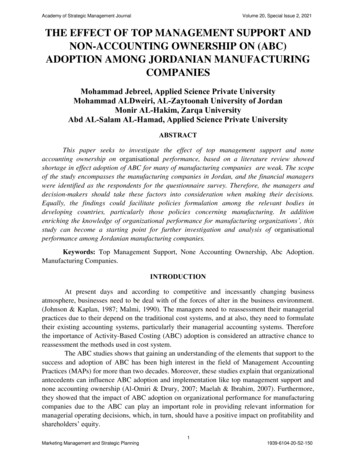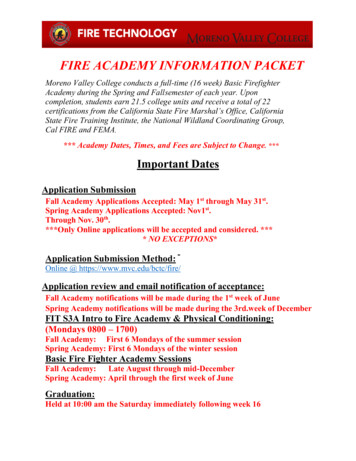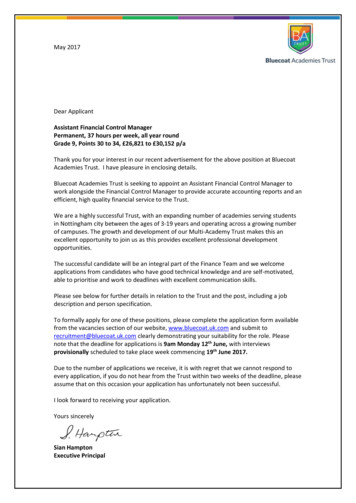
Transcription
Academy of Strategic Management JournalVolume 20, Special Issue 2, 2021THE EFFECT OF TOP MANAGEMENT SUPPORT ANDNON-ACCOUNTING OWNERSHIP ON (ABC)ADOPTION AMONG JORDANIAN MANUFACTURINGCOMPANIESMohammad Jebreel, Applied Science Private UniversityMohammad ALDweiri, AL-Zaytoonah University of JordanMonir AL-Hakim, Zarqa UniversityAbd AL-Salam AL-Hamad, Applied Science Private UniversityABSTRACTThis paper seeks to investigate the effect of top management support and noneaccounting ownership on organisational performance, based on a literature review showedshortage in effect adoption of ABC for many of manufacturing companies are weak. The scopeof the study encompasses the manufacturing companies in Jordan, and the financial managerswere identified as the respondents for the questionnaire survey. Therefore, the managers anddecision-makers should take these factors into consideration when making their decisions.Equally, the findings could facilitate policies formulation among the relevant bodies indeveloping countries, particularly those policies concerning manufacturing. In additionenriching the knowledge of organizational performance for manufacturing organizations’, thisstudy can become a starting point for further investigation and analysis of organisationalperformance among Jordanian manufacturing companies.Keywords: Top Management Support, None Accounting Ownership, Abc Adoption.Manufacturing Companies.INTRODUCTIONAt present days and according to competitive and incessantly changing businessatmosphere, businesses need to be deal with of the forces of alter in the business environment.(Johnson & Kaplan, 1987; Malmi, 1990). The managers need to reassessment their managerialpractices due to their depend on the traditional cost systems, and at also, they need to formulatetheir existing accounting systems, particularly their managerial accounting systems. Thereforethe importance of Activity-Based Costing (ABC) adoption is considered an attractive chance toreassessment the methods used in cost system.The ABC studies shows that gaining an understanding of the elements that support to thesuccess and adoption of ABC has been high interest in the field of Management AccountingPractices (MAPs) for more than two decades. Moreover, these studies explain that organizationalantecedents can influence ABC adoption and implementation like top management support andnone accounting ownership (Al-Omiri & Drury, 2007; Maelah & Ibrahim, 2007). Furthermore,they showed that the impact of ABC adoption on organizational performance for manufacturingcompanies due to the ABC can play an important role in providing relevant information formanagerial operating decisions, which, in turn, should have a positive impact on profitability andshareholders’ equity.1Marketing Management and Strategic Planning1939-6104-20-S2-150
Academy of Strategic Management JournalVolume 20, Special Issue 2, 2021Previous studies on the ABC adoptions focused in developed countries, (e.g. Fawzi,2008; JawaharLal, 2009; Askarany & Yazdifar, 2009; Pavlatos & Paggios, 2009; Rahmouni &Charaf, 2010; Rajasekaran, et al., 2011; Saxena et al., 2011; Arora, 2013; Horngren et al., 2013;Shaban, 2014). Few studies was focusing in developing countries such as Jordan (Moalla, 2007;Sartorius et al., 2007; Majid & Sulaiman, 2008; Maelah, 2010; Fei & Isa, 2010; Rbaba'h, 2012;& Mansour, 2015). As will existing studies also, give more attention for manufacturingorganization, (e.g. Baird et al., 2007; Al-Omiri & Drury, 2007; Yazdifar & Tsameny, 2012) andfew studies investigated the relationships in the services organizations (Rbaba'h, 2012; Hutibat,2012; Nassar et al., 2013; Mansour, 2015).Some researchers (Nassar et al., 2009; Al-Refa’ee, 2012; Rbaba'h, 2012; Nassar, 2013)state that the most cited factors that facilitate the decision to adopt ABC are adequate supportfrom top management and the role of none accounting ownership (Al-Refa’ee, 2012; Rbaba'h,2012; Nassar, 2013). The level of awareness about the ABC system among financial managers inhigh positions is an important factor in its successful adoption in Jordanian companies it can beenhance their performance because the competition levels in Jordan will be influenced greatly bythe adoption of the ABC system; this type of system greatly increases profitability, whichtherefore allows companies to control costs and compete more effectively (Al-kahdash & Nassar,2010; Al-Refa’ee, 2012; Rbaba'h, 2012). Within the Jordanian case, Jordan is a developingcountry. It is very attractive for foreign investments, due too many reasons such as safety,political stability and its central location in the Middle East. In same time the industry sector inJordan is separated into two parts the manufacturing and mining sector that contains of theChemical, Electrical, Engineering and Construction (Jaradat et al., 2018). The manufacturingsector significantly support to promoting the Jordanian dinar exchange rate in light of theirstability by supporting the Jordanian foreign currency reserves (Jaradat et al., 2018). Asmentioned in Jaradat, et al., (2018), the sector of manufacturing greatly affects the achievementof financial stability through support the treasury every year from the direct and indirect taxes.THEORETICAL REVIEWTop Management SupportTop management support is required to manifest a policy into objectives, goals andstrategies. Top managers are responsible for achieving targets and meeting for project’s needs.They should share the firm’s vision of the future, and they are held responsible for a company’ssuccess (Amran, 2011; Mustapa, 2013). Furthermore, the top management support is defined asthe role that top management plays in ABC adoption through making decisions that could affecteverybody involved, holding them responsible for rendering them to adopt ABC and utilisingfunds to adopt the system (Jibril, 2018).None Accounting OwnershipGenerally, an ABC system is solely owned by accountants, while other users tend to beexcluded to satisfy accountants’ needs. A crucial factor in companies’ failure to share ownershipwith non-accountants is adoption experience. Thus, non-accounting ownership and support oftop managers, greatly influences ABC adoption (Brick & Chidambaran, 2007; Maelah et al.,2Marketing Management and Strategic Planning1939-6104-20-S2-150
Academy of Strategic Management JournalVolume 20, Special Issue 2, 20212010; Amran, 2011; Jebril, 2018) mentioned that the non-accounting ownership have basic rolein ABC adoption in Jordanian manufacturing companies.ABC AdoptionAdoption is a term defined by Saya, Pee & Kankanhalli, (2010) as the acceptance and theuse of something new. In light of technology adoption, adoption refers to a decision to makecomplete use of an innovation as the available top course of action (Rogers, 2003). In the contextof the organization, Deering, Tatnall & Burgess, (2012) linked adoption to the admission of anovel innovation for the purpose of adoption. In relation to the research topic, adoption refers tothe acceptance of the ABC as an innovation in the organizations. Notably, the upsurge inresearchers’ and practitioners’ interest in the implementation of ABC in organizations hasoccurred as a result of ABC’s superiority over traditional costing methods and its significance inenhancing organizational performance (Fei & Isa, 2010; Fatma & Habib, 2014; Jibril, 2018).HYPOTHESIS DEVELOPMENTThe concept of activity based costing system adoption are merged in one conceptualframework. Figure (1) explains the framework of study. In this conceptual framework, the mainelement ABC adoption by (top management support, non-accounting ownership) and ABCadoption independent and dependent variables respectively. This study seeks to bridge the gap byproviding a basis for discerning the impact the ABC factor successes.Top Management Support and ABC adoptionThe main factors for the success of an innovation depend on the maximum rankingmanagements such as chairman, president, executive directors, executive vice presidents that isresponsible for the entire organizations (Walton, 1987; Hoffman, 1999; Scott, 1994; Cobb, 1992;Johnson, 1987; Lana, 2007; Sheild, 1996; Taba, 2005; Sheild, 1995 ). Also, they mentioned thatthe top management support the main factor can give the high degree in ABC adoption andimplementation system. Furthermore, Ruhanita (2006) explained that the top managementsupport link ABC to performance measure and affected on the ABC success adoptionsignificantly.Top management contribute to achieve the policy into aims, goals, and plans, thus itsmakes decisions that have an effect on everyone in the company and is detained completelyaccountable for the achievement or failure of the business. Gosselin (1997) explained that therole impact of top management support for each stage of ABC adoption process inmanufacturing firms. Based above discussion, this study proposes the following hypotheses fortesting:H1: The top management support is positively related to ABC adoption.Non Accounting Ownership and ABC adoptionThe previous studies mentioned the role of accounting ownership have possessed threatsof ABC adoption due to have good execution knowledge in cost system (Sheild, 1985; Johnson,1987; Shield, 1996; Norries, 1995; Mohammed, 2007; Jibril, 2018). Therefore, Krumwidev3Marketing Management and Strategic Planning1939-6104-20-S2-150
Academy of Strategic Management JournalVolume 20, Special Issue 2, 2021reported that the non- accounting ownership has significant role in affect each stage of ABCadoption process in manufacturing and service companies. Due to when the companies need toaccomplish adopt or implement new system the accountants not succeed in distributionpossession with non-accountants.Ruhanita (2006); Jibril (2018) explained that the top management support, Nonaccounting ownership has significant role ABC to performance measure and influenced the ABCsuccess adoption significantly. Additionally, Cooper (1992) found that the existence ofaccounting staff can be give effective role on ABC adoption and implementation. From theaforementioned discussion, therefore, the following hypothesis is proposed by this study:H2: The Non-accounting ownership is positively related to ABC adoption.RESEARCH MODELIn general, the contingency theory is an organizational theory that based that the best wayto lead the company, or to make decisions, the optimal action is contingent upon the internal andexternal situation of the company (Fiedler, 1964). The contingency perspective has beenemployed in management accounting studies to indicate a range of contingent variablesincluding organization structure (Chia, 1995; Gosselin et al., 2005), training (Chenhall &Langfield-Smith, 1998b), and accounting information system design (Otley, 1980).Contingency theory explains the factors that impact on the ABC adoption (Anderson etal., 2002; Kallunki & Silvola, 2008; Liu & Skillet, 2007; Cadez & Guilding, 2008; Jibril, 2018).In the late 1980s, ABC was as a new costing technique procedure that offered cost data that ismore as accurate compared with to the traditional costing system. Then, in 1990, the contingencytheory has been employed in examining the factors that impact the adoption of the systems.Based on this theory, there has been change on the present management accounting practices inorder to responding the conditions faced by firms; thus, these the change to practice wereinfluenced by the contextual and organizational factors and these are turned as contingencyfactors (Jebril, 2018).According to the contingency theory perspective, this research will explain the role of topmanagement support, and non-accounting ownership from the internal organizational such ascontextual and organizational factors and external environmental variables. These factors willdirectly impact the ABC adoption. The significant determinant of ABC adoption is thecontingent fit between the organizational internal and the contingencies. Meanwhile, theframework of contingency theory reported the factors influencing its adoption. Hence, thesefactors have influence on the choice of accounting and information systems. This enables themanagers and companies to adapt quickly to changing markets and technologies for the adoptingaccounting and organizational changes, thus is very important to understand what is driving thesechanges on strategies and organizational performance in organizations.4Marketing Management and Strategic Planning1939-6104-20-S2-150
Academy of Strategic Management JournalVolume 20, Special Issue 2, 2021FIGURE 1ABC FACTORS IN ABC ADOPTIONRESEARCH METHODOLOGYZikmund et al., (2013) explained that objectives, availability of information, and cost forconducting research, are factors influencing the choice of research design. Hence, this studyadopts a survey method since the data obtained from a survey is used to examine therelationships between the dependent and independent variables (Bryman & Bell, 2015). Inaddition, as the respondent is financial managers, has expected to be highly educated, making asurvey approach the most suitable technique for this context (Cooper et al., 2006). Anotheradvantage of the survey strategy is that a large amount of data can be gathered from respondents,and the results can be generalized to the population at large (Jarrdat, 2018).The instruments used in this research based on Oppenheim's (2000) guidelines. Inparticular, Oppenheim (2000) mentioned that an instrument should fulfil two requirements:relevancy and accuracy. In terms of fulfilling the relevancy requirement, this study employedquestionnaires to gather information on the research objectives. Concerning the fulfilment of theaccuracy requirement, (Zikmund et al., 2013).The impact of top management support and none accounting ownership on the ABCadoption was examined in this study via the application of questionnaires distributed to financialmanagers of 291 randomly selected Jordanian manufacturing companies. The questionnaireconsists of three main sections: Part A to Part C Part A gathers demographic data of therespondent and his/ her companies. Part B focused on the factors (Top management support,none accounting ownership) influencing the ABC adoption; Part C gathers data relatedinformation about ABC adoption in companies.Five items representing the construct of top management support and ABC adoption weresupplemented with a 5-point Likert scale S1-S5 range as well where S1 “strongly disagree”while S5 signifies “strongly agree.” Three items representing the construct of none accountingownership were supplemented with a 5-point Likert scale with S1-S5 range as well where S1“strongly disagree” while S5 signifies “strongly agree.” Meanwhile, a total of six items wererepresenting the construct of ABC adoption.5Marketing Management and Strategic Planning1939-6104-20-S2-150
Academy of Strategic Management JournalVolume 20, Special Issue 2, 2021RESULTS AND DISCUSSIONData AnalysisFactor analysis was in this research, and evaluation was made to the measures of theconstruct to determine both its reliability and validity. Further, the model proposed in this studydemonstrates the used variables’ unidimensionality, in the explaining of factor analysis. Withthe use of AMOS-SEM, the (measurement model) and the (structural model) were evaluatedafter the data have been checked and screened. In particular, AMOS-SEM analysed this study’sdirect results.Measurement ModelBased on the Amos-SEM, the component measurement was included in the model andthis model provides the determination the indicators (items) hypothetically and link to theresultant constructs. In this study, the model analysis results affirm that the items of the surveymeasure the constructs as they should, affirming both their validity and reliability.Table 1CONVERGENT VALIDITY .84ABCA50.81ABCA60.84For each construct used in this study, its values of CR and Cronbach’s alpha weredetermined (see Table 1). The constructs used in this study all achieved the values of CR andCronbach’s alpha that are greater than the suggested threshold value of 0.70 (see Hair et al.,2013; Henseler et al., 2009; Wong, 2013). Furthermore, Henseler, et al., (2009) elaborated thatconvergent validity relates to the degree to which measures of constructs with theoretical6Marketing Management and Strategic Planning1939-6104-20-S2-150
Academy of Strategic Management JournalVolume 20, Special Issue 2, 2021association are linked. As mentioned in Hair, et al., (2013), the achieved value shows the level oflinkage among the measures of similar construct.Hypotheses TestingIn this study, the test was executed on the hypothesised model with the first stage inapplication of Amos-SEM algorithm. Accordingly, as explained in Table 2:Table 2RESULTS OF HYPOTHESIZED DIRECT EFFECTS OFTHE uesTMS ABCA0.23.2750.075H1 SupportedNAO ABCA0.2684.0360H2 SupportedDecisionConcerning with the path between TMS, NAO constructs and ABCA construct(Hypotheses (H1 and H2), the beta coefficient is positive and statistically significant at pvalue 0.001 (β 0.200; t 3.275 and β 0.268; t 4,036, respectively).Discussion of ResultsThis study found that the relationship between TMS and NAO with ABC adoption ispositive; this result supported by hypothesis H1 and H2. Based on that, it seems that TMS andNAO make effective of and improve ABC adoption. This result in line with studies that supporta positive relationship between TMS and ABC adoption (Nassar et al., 2011; Al-Refa’ee, 2012;Fadzi & Rababah, 2012; Rababah, 2014). Also, this result in line with studies that support apositive relationship between NAO and ABC adoption (Nassar et al., 2011; Al-Refaee, 2012;Rababah, 2012).Based above discussion in the previous sections, the following framework is proposed,explained by Figure 1, for this study. This paper aim to investigate the roles of the ABC factorson ABC adoption among Jordanian manufacturing companies. The study seek to as a wake-upcall for reforming the management practices in Jordan. To achieve this proposed, namely, Nonaccounting ownership, top management support on the other hand the two hypotheses aredeveloped to validate the hypothesis survey research will be undertaken.CONCLUSIONS AND RECOMMENDATIONThe calls for additional research using a contingency perspective to improve theunderstanding of ABC adoption in manufacturing companies and the increasing importance ofmanufacturing companies globally, especially in developing countries has motivated this study.Therefore, among manufacturing companies, this study explores top management support andnone accounting ownership in terms of the factors impacting on ABC adoption.Considering the positive impact top management support and none accounting ownershipon ABC adoption, the managers and decision-makers should increase the knowledge of ABC7Marketing Management and Strategic Planning1939-6104-20-S2-150
Academy of Strategic Management JournalVolume 20, Special Issue 2, 2021adoption. Likewise, professional bodies should enrich the knowledge of ABC adoptionparticularly concerning in manufacturing companies through the use of workshops andconferences. As the impact top management support and none accounting ownership on improvethe level of ABC adoption, policymakers should encourage these role on ABC adoption inmanufacturing companies. Therefore, considering the positive impact of these factors on ABCadoption, managers and decision-makers in manufacturing companies should take these factorsinto consideration when making their decisions.This study provides knowledge on ABC adoption in manufacturing companies indeveloping countries. According to study results, the concerned bodies could be assisted inreformulating the policies associated with manufacturing companies. Also, the awareness offactors affecting ABC adoption assists the professional bodies in the enrichment ofmanufacturing companies understanding particularly concerning the ABC adoption affectingfactors. In the context of manufacturing companies, this study can stimulate more scrutiny andanalysis concerning manufacturing companies.However, there are several limitations related to this study which are worth considering.Firstly, the variables employed in this study were limited and this may cause the neglect ofcertain vital variables. Hence, there is merit in having the understanding of other factors relatedto ABC adoption on manufacturing companies. Accordingly, among these factors are: training,information technology, and organisational culture as well. Another notable limitation is the useof limited sample in this study, whereby it consisted the manufacturing companies. The use oflimited sample reduces the generalizability of the outcomes of this study to other types oforganisations in other industries. Hence, it might be of value to consider other sectors, forinstance, the service sector, as this would allow comparison of outcomes, increasing thegeneralisation.REFERENCESAl-Khadash, H., & Feridun, M. (2006). Impact of strategic initiatives in management accounting on corporatefinancial performance: Evidence from Amman Stock Exchange. Managing Global Transitions, 4(4), 299–313.Abu-Tapanjeh, A.M. (2008). Activity-based costing approach to handle the uncertainty costing of higher educationalinstitutions: Perspective from an academic college. JKAU: Econ. & Adm, 22, 29-57.Anderson, S.W. (1995b). A framework for assessing cost management system changes: The case of activity basedcosting implementation at general motors, 1986-1993. Journal of Management Accounting Research, 7, 1-51.Anderson, S., & YOUNG, S. (2001). The impact of contextual and process factors on the evaluation of activitybased costing systems. Accounting, Organizations and Society, 24, 525-559.Anthony, R.N. (1989). Reminiscences about management accounting. Journal of Management AccountingResearch, 1, 1-20.Armitage, H.M., & Nicholson, R. (1993). Activity-Based costing: A survey of Canadian practice. Society ofManagement Accountants of Canada, 3.Babad, Y.M., & Balachandran, B.V. (1993). “Cost driver optimization in activity-based costing”. The AccountingReview, 68(3), 563-575.Chongruksut, W. (2002). The adoption of activity-based costing in Thailand. Unpublished PhD, Victoria University.Cooper, R.B., & Zmud, R.W. (1990). Information technology implementation research: A technological diffusionapproach. Management Science, 36(2), 123–139.Cooper, R., & Kaplan, R.S. (1991). Profit priorities from activity-based costing. Harvard Business Review, 130-137.Cooper, R., & Kaplan, R.S. (1992). Activity-Based systems: Measuring the costs of resource usage. AccountingHorizons, 6(3), 1.Green, F.B., & Amenkhienan, F.E. (1992). Accounting innovations: A cross-sectional survey of manufacturingfirms. Journal of Cost Management for the Manufacturing Industry, 58-64.Gosselin, M. (1997). The effect of strategy and organizational structure on the adoption and implementation ofActivity-Based Costing. Accounting, Organizations and Society, 22(2), 105-122.8Marketing Management and Strategic Planning1939-6104-20-S2-150
Academy of Strategic Management JournalVolume 20, Special Issue 2, 2021Hoffman, R.C. (1999). Organizational innovation: Management influence across cultures. Multinational. Bus, 7(1),37.Innes, J., & Mitchell, F. (1991). ABC: A survey of CIMA Members. Management accounting (UK), 28-30.Fie, Z., & Isa, C. (2010). Factors influencing activity-based costing success: A research framework. InternationalJournal of Trade, Economics and Finance, 1(2).Johnson, H.T., & Kaplan, R.S. (1987). Relevance lost. The rise and fall of management accounting. Boston, MA.Harvard Business School Press.Lana, Y.J.L., & Fei, P. (2007). The implementation of activity-based costing in China. An innovation actionresearch approach. 39(3), 249-264.McGowan, A.S., & Klammer, T.P. (1997). Satisfaction with activity-based cost management implementation. J.Manage, 9, 217-237.Ministry of Planning Report, the Economic indicators 2007, Amman, Jordan, 2007MacArthur, J.B. (1996). From activity-based costing to throughput accounting. Management accounting, 30(34), 3638.Mohammed, A.O., & Colin, D. (2007). Organizational and behavioral factors influencing the adoption and successof ABC in the UK. Cost, Manage, 21(6), 38-48.Norris, G. (1997). The formation of managers' views of ABC and their impact on the outcome of its use. Agrounded theory case study' Acc. Res. J., 10(2), 180-200.Ruhanita, M., & Daing, N.I. (2006). Activity Based Costing (ABC) adoption among manufacturing organizations The Case of Malaysia. Inter. J. Bus. Soc., 7(1), 70-101.Shields, M., & Young, S. (1989). A behavioral model for implementing cost management systems. Journal of CostManagement, winter, 17-27.Shield, (1995). An empirical analysis of firms' implementation experiences with Activity-Based CostingManagement Accounting Research, 7, 148-166.Taba, L.M. (2005). Measuring the successful implementation of Activity Based Costing (ABC) in the South Africanpost office unpublished master thesis. University of South Africa.Valanciene, L., & Gimzauskiene, E. (2007). Changing role of management accounting: Lithuanian experience casestudies. Inzinerine Economical Engineering Economics (5), 16-23.9Marketing Management and Strategic Planning1939-6104-20-S2-150
The concept of activity based costing system adoption are merged in one conceptual framework. Figure (1) explains the framework of study. In this conceptual framework, the main element ABC adoption by (top management support, non-accounting ownership) and ABC adoption independent and dependent variables respectively.











